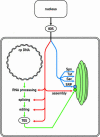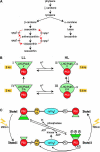Genetics of the biogenesis and dynamics of the photosynthetic machinery in eukaryotes
- PMID: 15235122
- PMCID: PMC514150
- DOI: 10.1105/tpc.160770
Genetics of the biogenesis and dynamics of the photosynthetic machinery in eukaryotes
Figures



Similar articles
-
PGRL1 and LHCSR3 Compensate for Each Other in Controlling Photosynthesis and Avoiding Photosystem I Photoinhibition during High Light Acclimation of Chlamydomonas Cells.Mol Plant. 2017 Jan 9;10(1):216-218. doi: 10.1016/j.molp.2016.09.005. Epub 2016 Sep 28. Mol Plant. 2017. PMID: 27693674 No abstract available.
-
The dynamics of photosynthesis.Annu Rev Genet. 2008;42:463-515. doi: 10.1146/annurev.genet.42.110807.091452. Annu Rev Genet. 2008. PMID: 18983262 Review.
-
State transitions--the molecular remodeling of photosynthetic supercomplexes that controls energy flow in the chloroplast.Biochim Biophys Acta. 2011 Aug;1807(8):897-905. doi: 10.1016/j.bbabio.2010.11.005. Epub 2010 Nov 23. Biochim Biophys Acta. 2011. PMID: 21108925 Review.
-
Excitation energy transfer in Chlamydomonas reinhardtii deficient in the PSI core or the PSII core under conditions mimicking state transitions.Biochim Biophys Acta. 2016 Jun;1857(6):625-33. doi: 10.1016/j.bbabio.2016.03.002. Epub 2016 Mar 3. Biochim Biophys Acta. 2016. PMID: 26946087
-
Origins. On the origin of photosynthesis.Science. 2009 Mar 6;323(5919):1286-7. doi: 10.1126/science.323.5919.1286. Science. 2009. PMID: 19264999 No abstract available.
Cited by
-
Algal Functional Annotation Tool: a web-based analysis suite to functionally interpret large gene lists using integrated annotation and expression data.BMC Bioinformatics. 2011 Jul 12;12:282. doi: 10.1186/1471-2105-12-282. BMC Bioinformatics. 2011. PMID: 21749710 Free PMC article.
-
Diatom PtCPF1 is a new cryptochrome/photolyase family member with DNA repair and transcription regulation activity.EMBO Rep. 2009 Jun;10(6):655-61. doi: 10.1038/embor.2009.59. Epub 2009 May 8. EMBO Rep. 2009. PMID: 19424294 Free PMC article.
-
Analyzing lignin biosynthesis pathways in rattan using improved co-expression networks of NACs and MYBs.BMC Plant Biol. 2022 Aug 24;22(1):411. doi: 10.1186/s12870-022-03786-4. BMC Plant Biol. 2022. PMID: 36002818 Free PMC article.
-
Photosynthetic redox imbalance governs leaf sectoring in the Arabidopsis thaliana variegation mutants immutans, spotty, var1, and var2.Plant Cell. 2009 Nov;21(11):3473-92. doi: 10.1105/tpc.108.062752. Epub 2009 Nov 6. Plant Cell. 2009. PMID: 19897671 Free PMC article.
-
Eukaryotic microalgae genomics. The essence of being a plant.Plant Physiol. 2005 Feb;137(2):397-8. doi: 10.1104/pp.104.900136. Plant Physiol. 2005. PMID: 15710680 Free PMC article. No abstract available.
References
-
- Allen, J.F. (1992). Protein phosphorylation in regulation of photosynthesis. Biochim. Biophys. Acta 1098, 275–335. - PubMed
-
- Allen, J.F., Bennett, J., Steinback, K.E., and Arntzen, C.J. (1981). Chloroplast protein phosphorylation couples plastoquinone redox state to distribution of excitation energy between photosystems. Nature 291, 25–29.
-
- Alonso, J.M., et al. (2003). Genome-wide insertional mutagenesis of Arabidopsis thaliana. Science 301, 653–657. - PubMed
-
- Andersson, B., and Anderson, J.M. (1980). Lateral heterogeneity in the distribution of chlorophyll-protein complexes of the thylakoid membranes of spinach chloroplasts. Biochim. Biophys. Acta 593, 427–440. - PubMed
-
- Andersson, J., Wentworth, M., Walters, R.G., Howard, C.A., Ruban, A.V., Horton, P., and Jansson, S. (2003). Absence of the Lhcb1 and Lhcb2 proteins of the light-harvesting complex of photosystem II: Effects on photosynthesis, grana stacking and fitness. Plant J. 35, 350–361. - PubMed
Publication types
MeSH terms
Substances
LinkOut - more resources
Full Text Sources

